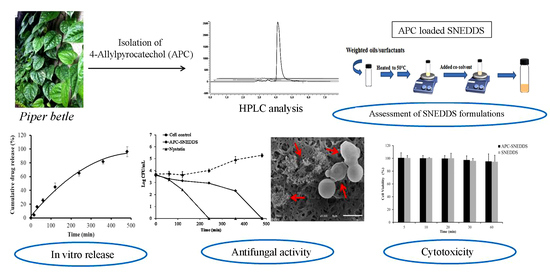Development of Self-Nanoemulsifying Drug Delivery Systems Containing 4-Allylpyrocatechol for Treatment of Oral Infections Caused by Candida albicans
Abstract
1. Introduction
2. Materials and Methods
2.1. Materials
2.2. High Performance Liquid Chromatography (HPLC) Analysis
2.3. Solubility of APC in Excipients and in Water
2.4. Experimental Design and Preparation of SNEDDS Formulations
2.5. Investigation of Self-Emulsification Efficiency
- Grade A:
- A NE with a clear or bluish appearance was rapidly formed within 1 min.
- Grade B:
- A less clear emulsion with a bluish-white appearance was rapidly formed.
- Grade C:
- A fine milky emulsion was formed within 2 min.
- Grade D:
- A dull, grayish-white emulsion with slightly oily appearance was slowly formed (longer than 2 min).
- Grade E:
- Poor or minimal emulsification with large oil globules was present on the surface.
2.6. Measurement of Particle Size, Size Distribution, and Zeta Potential
2.7. Solubility of APC in SNEDDS
2.8. Preparation and Characterization of APC-SNEDDS
2.9. Morphology Study
2.10. In Vitro Release
2.11. Evaluation of Antifungal Activity
2.11.1. Killing Kinetics
2.11.2. Effects on Destruction of Candida Cells
2.12. Cytotoxicity to Fibroblast Cells
2.13. Statistical Analysis
3. Results and Discussion
3.1. Solubility of APC and Selection of Excipients
3.2. Preparation of SNEDDS Formulations
3.3. Self-Emulsification Efficiency and Particle Characteristics
3.4. Solubility of APC in SNEDDS Formulations
3.5. Preparation and Characterization of APC-SNEDDS
3.6. Morphology Study
3.7. In Vitro Release
3.8. Antifungal Activity
3.8.1. Killing Kinetics
3.8.2. Effect on the Destruction of Candida Cells
3.9. Cytotoxicity to Fibroblast Cells
4. Conclusions
Author Contributions
Funding
Institutional Review Board Statement
Informed Consent Statement
Data Availability Statement
Acknowledgments
Conflicts of Interest
References
- Jabra-Rizk, M.A.; Kong, E.F.; Tsui, C.; Nguyen, M.H.; Clancy, C.J.; Fidel, P.L.; Noverr, M. Candida albicans pathogenesis: Fitting within the host-microbe damage response framework. Infect. Immun. 2016, 84, 2724–2739. [Google Scholar] [CrossRef] [PubMed]
- Gleiznys, A.; Zdanavičienė, E.; Žilinskas, J. Candida albicans importance to denture wearers. A literature review. Stomatologija 2015, 17, 54–66. [Google Scholar] [PubMed]
- Williams, D.; Lewis, M. Pathogenesis and treatment of oral candidosis. J. Oral Microbiol. 2011, 3. [Google Scholar] [CrossRef] [PubMed]
- Pellizzaro, D.; Polyzois, G.; Machado, A.L.; Giampaolo, E.T.; Sanitá, P.V.; Vergani, C.E. Effectiveness of mechanical brushing with different denture cleansing agents in reducing in vitro Candida albicans biofilm viability. Braz. Dent. J. 2012, 23, 547–554. [Google Scholar] [CrossRef] [PubMed]
- Depaola, L.G.; Spolarich, A.E. Safety and efficacy of antimicrobial mouthrinses in clinical practice. J. Dent. Hyg. 2007, 81, 117. [Google Scholar]
- Abdullah, N.F.; Hussain, R.M. Isolation of allylpyrocatechol from Piper betle L. leaves by using high-performance liquid chromatography. J. Liq. Chromatogr. Relat. Technol. 2015, 38, 289–293. [Google Scholar] [CrossRef]
- Phumat, P.; Khongkhunthian, S.; Wanachantararak, P.; Okonogi, S. Potential of Piper betle extracts on inhibition of oral pathogens. Drug Discov. Ther. 2017, 11, 307–315. [Google Scholar] [CrossRef][Green Version]
- Phumat, P.; Khongkhunthian, S.; Wanachantararak, P.; Okonogi, S. Comparative inhibitory effects of 4-allylpyrocatechol isolated from Piper betle on Streptococcus intermedius, Streptococcus mutans, and Candida albicans. Arch. Oral Biol. 2020, 113, 104690. [Google Scholar] [CrossRef]
- Phumat, P.; Khongkhunthian, S.; Wanachantararak, P.; Okonogi, S. Effects of Piper betle fractionated extracts on inhibition of Streptococcus mutans and Streptococcus intermedius. Drug Discov. Ther. 2018, 12, 133–141. [Google Scholar] [CrossRef]
- Kaypetch, R.; Thaweboon, S. Antifungal property of Piper betle leaf oil against oral Candida species. MATEC Web Conf. 2018, 242, 1–4. [Google Scholar] [CrossRef][Green Version]
- Khumpirapang, N.; Pikulkaew, S.; Müllertz, A.; Rades, T.; Okonogi, S. Self-microemulsifying drug delivery system and nanoemulsion for enhancing aqueous miscibility of Alpinia galanga oil. PLoS ONE 2017, 12, e0188848. [Google Scholar]
- Kheawfu, K.; Pikulkaew, S.; Rades, T.; Müllertz, A.; Okonogi, S. Development and characterization of clove oil nanoemulsions and self-microemulsifying drug delivery systems. J. Drug Deliv. Sci. Technol. 2018, 46, 330–338. [Google Scholar] [CrossRef]
- Savla, R.; Browne, J.; Plassat, V.; Wasan, K.M.; Wasan, E.K. Review and analysis of FDA approved drugs using lipid-based formulations. Drug Dev. Ind. Pharm. 2017, 43, 1743–1758. [Google Scholar] [CrossRef] [PubMed]
- Pouton, C.W. Formulation of poorly water-soluble drugs for oral administration: Physicochemical and physiological issues and the lipid formulation classification system. Eur. J. Pharm. Sci. 2006, 29, 278–287. [Google Scholar] [CrossRef] [PubMed]
- Sakthi, U.M.; Lobo, F.J.R.; Uppuluri, K.B. Self nano emulsifying drug delivery systems for oral delivery of hydrophobic drugs. Biomed. Pharmacol. J. 2013, 6, 355–362. [Google Scholar]
- Date, A.A.; Desai, N.; Dixit, R.; Nagarsenker, M. Self-nanoemulsifying drug delivery systems: Formulation insights, applications and advances. Nanomedicine 2010, 5, 1595–1616. [Google Scholar] [CrossRef]
- Martins, S.; Sarmento, B.; Ferreira, D.C.; Souto, E.B. Lipid-based colloidal carriers for peptide and protein delivery—Liposomes versus lipid nanoparticles. Int. J. Nanomed. 2007, 2, 595–607. [Google Scholar]
- Constantinides, P.P. Lipid microemulsions for improving drug dissolution and oral absorption: Physical and biopharmaceutical aspects. Pharm. Res. 1995, 2, 1561–1572. [Google Scholar] [CrossRef]
- Ren, S.; Mu, H.; Alchaer, F.; Chtatou, A.; Müllertz, A. Optimization of self nanoemulsifying drug delivery system for poorly water-soluble drug using response surface methodology. Drug Dev. Ind. Pharm. 2013, 39, 799–806. [Google Scholar] [CrossRef]
- Kassem, A.A.; Mohsen, A.M.; Ahmed, R.S.; Essam, T.M. Self-nanoemulsifying drug delivery system (SNEDDS) with enhanced solubilization of nystatin for treatment of oral candidiasis: Design, optimization, in vitro and in vivo evaluation. J. Mol. Liq. 2016, 218, 219–232. [Google Scholar] [CrossRef]
- Rizvi, S.A.A.; Saleh, A.M. Applications of nanoparticle systems in drug delivery technology. Saudi Pharm. J. 2018, 26, 64–70. [Google Scholar] [CrossRef] [PubMed]
- Tima, S.; Anuchapreeda, S.; Ampasavate, C.; Berkland, C.; Okonogi, S. Stable curcumin-loaded polymeric micellar formulation for enhancing cellular uptake and cytotoxicity to FLT3 overexpressing EoL-1 leukemic cells. Eur. J. Pharm. Biopharm. 2017, 114, 57–68. [Google Scholar] [CrossRef] [PubMed]
- Schmidt, J.; Zyba, V.; Jung, K.; Rinke, S.; Haak, R.; Mausberg, R.F.; Ziebolz, D. Cytotoxic effects of octenidine mouth rinse on human fibroblasts and epithelial cells—An in vitro study. Drug Chem. Toxicol. 2016, 39, 322–330. [Google Scholar] [CrossRef] [PubMed]
- Rahman, M.A.; Iqbal, Z.; Hussain, A. Formulation optimization and in vitro characterization of sertraline loaded self-nanoemulsifying drug delivery system (SNEDDS) for oral administration. J. Pharm. Investig. 2012, 42, 191–202. [Google Scholar] [CrossRef]
- Kotta, S.; Khan, A.W.; Ansari, S.H.; Sharma, R.K.; Ali, J. Formulation of nanoemulsion: A comparison between phase inversion composition method and high-pressure homogenization method. Drug Deliv. 2015, 22, 455–466. [Google Scholar] [CrossRef]
- Matsaridou, I.; Barmpalexis, P.; Salis, A.; Nikolakakis, I. The influence of surfactant HLB and oil/surfactant ratio on the formation and properties of self-emulsifying pellets and microemulsion reconstitution. AAPS PharmSciTech 2012, 13, 1319–1330. [Google Scholar] [CrossRef]
- Olorunsola, E.O.; Adedokun, M.O. Surface activity as basis for pharmaceutical applications of hydrocolloids: A review. J. Appl. Pharm. Sci. 2014, 4, 110–116. [Google Scholar] [CrossRef]
- Weerapol, Y.; Limmatvapirat, S.; Nunthanid, J.; Sriamornsak, P. Self-nanoemulsifying drug delivery system of nifedipine: Impact of hydrophilic–lipophilic balance and molecular structure of mixed surfactants. AAPS PharmSciTech 2014, 15, 456–464. [Google Scholar] [CrossRef]
- Cerpnjak, K.; Zvonar, A.; Gasperlin, M.; Vrecer, F. Lipid-based systems as a promising approach for enhancing the bioavailability of poorly water-soluble drugs. Acta Pharm. 2013, 63, 427–445. [Google Scholar] [CrossRef]
- Zeng, L.; Xin, X.; Zhang, Y. Development and characterization of promising Cremophor EL-stabilized o/w nanoemulsions containing short-chain alcohols as a cosurfactant. RSC Adv. 2017, 7, 19815–19827. [Google Scholar] [CrossRef]
- Michaelsen, M.H.; Wasan, K.M.; Sivak, O.; Müllertz, A.; Rades, T. The Effect of digestion and drug load on halofantrine absorption from self-nanoemulsifying drug delivery system (SNEDDS). AAPS J. 2016, 18, 180–186. [Google Scholar] [CrossRef] [PubMed]
- Li, P.; Nielsen, H.M.; Müllertz, A. Impact of lipid-based drug delivery systems on the transport and uptake of insulin across Caco-2 cell monolayers. J. Pharm. Sci. 2016, 105, 2743–2751. [Google Scholar] [CrossRef] [PubMed]
- Rehman, F.U.; Shah, K.U.; Shah, S.U.; Khan, I.U.; Khan, G.M.; Khan, A. From nanoemulsions to self-nanoemulsions, with recent advances in self-nanoemulsifying drug delivery systems (SNEDDS). Expert Opin. Drug Deliv. 2017, 14, 1325–1340. [Google Scholar] [CrossRef] [PubMed]
- Stetefeld, J.; McKenna, S.A.; Patel, T.R. Dynamic light scattering: A practical guide and applications in biomedical sciences. Biophys. Rev. 2016, 8, 409–427. [Google Scholar] [CrossRef] [PubMed]
- Danaei, M.; Dehghankhold, M.; Ataei, S.; Hasanzadeh Davarani, F.; Javanmard, R.; Dokhani, A.; Khorasani, S.; Mozafari, M.R. Impact of particle size and polydispersity index on the clinical applications of lipidic nanocarrier systems. Pharmaceutics 2018, 10, 57. [Google Scholar] [CrossRef]
- Bhandari, V.; Avachat, A. Formulation and characterization of self emulsifing pellets of carvedilol. Braz. J. Pharm. Sci. 2015, 51, 663–672. [Google Scholar] [CrossRef][Green Version]
- Nasr, A.; Gardouh, A.; Ghonaim, H.; Abdelghany, E.; Ghorab, M. Effect of oils, surfactants and cosurfactants on phase behavior and physicochemical properties of self-nanoemulsifying drug delivery system (SNEDDS) for irbesartan and olmesartan. Int. J. Appl. Pharm. 2016, 8, 13–24. [Google Scholar]
- Belhadj, Z.; Zhang, S.; Zhang, W.; Wang, J. Formulation development and bioavailability ealuation of a self-nanoemulsifying drug delivery system ( SNEDDS ) of atorvastatin calcium. Int. J. Pharm. 2013, 29, 2051–5782. [Google Scholar]
- Aboulfotouh, K.; Allam, A.A.; El-Badry, M.; El-Sayed, A.M. Development and in vitro/in vivo performance of self-nanoemulsifying drug delivery systems loaded with candesartan cilexetil. Eur. J. Pharm. Sci. 2017, 109, 503–513. [Google Scholar] [CrossRef]
- Masarudin, M.J.; Cutts, S.M.; Evison, B.J.; Phillips, D.R.; Pigram, P.J. Factors determining the stability, size distribution, and cellular accumulation of small, monodisperse chitosan nanoparticles as candidate vectors for anticancer drug delivery: Application to the passive encapsulation of [14C]-doxorubicin. Nanotechnol. Sci. Appl. 2015, 8, 67–80. [Google Scholar] [CrossRef]
- Patel, J.; Kevin, G.; Patel, A.; Raval, M.; Sheth, N. Design and development of a self-nanoemulsifying drug delivery system for telmisartan for oral drug delivery. Int. J. Pharm. Investig. 2011, 1, 112–118. [Google Scholar] [CrossRef] [PubMed]
- Moldoveanu, S.C. Pyrolysis of alcohols and phenols. In Pyrolysis of Organic Molecules, 2nd ed.; Moldoveanu, S.C., Ed.; Elsevier: Amsterdam, The Netherlands, 2018; pp. 207–278. [Google Scholar]
- Maier, G.P.; Bernt, C.M.; Butler, A. Catechol oxidation: Considerations in the design of wet adhesive materials. Biomater. Sci. 2018, 6, 332–339. [Google Scholar] [CrossRef] [PubMed]
- Klang, V.; Matsko, N.B.; Valenta, C.; Hofer, F. Electron microscopy of nanoemulsions: An essential tool for characterisation and stability assessment. Micron 2012, 43, 85–103. [Google Scholar] [CrossRef] [PubMed]
- Ke, Z.; Hou, X.; Jia, X. bin Design and optimization of self-nanoemulsifying drug delivery systems for improved bioavailability of cyclovirobuxine D. Drug Des. Devel. Ther. 2016, 10, 2049–2060. [Google Scholar] [CrossRef]
- Paarakh, M.P.; Jose, P.A.N.I.; Setty, C.M.; Peter, G. V Release Kinetics—Concepts and Applications. Int. J. Pharm. Res. Technol. 2019, 8, 12–20. [Google Scholar]
- Cycle, M.-C.; Jose, S.; Cinu, T.A.; Sebastian, R.; Shoja, M.H.; Aleykutty, N.A.; Durazzo, A.; Lucarini, M.; Santini, A.; Souto, E.B. Transferrin-conjugated docetaxel–PLGA nanoparticles for tumor targeting: Influence on MCF-7 cell cycle. Polymers 2019, 11, 1905. [Google Scholar]
- Martin, S.W.; Douglas, L.M.; Konopka, J.B. Cell cycle dynamics and quorum sensing in Candida albicans chlamydospores are distinct from budding and hyphal growth. Eukaryot. Cell 2005, 4, 1191–1202. [Google Scholar] [CrossRef]
- Dos Santos, A.G.; Marquês, J.T.; Carreira, A.C.; Castro, I.R.; Viana, A.S.; Mingeot-Leclercq, M.P.; De Almeida, R.F.M.; Silva, L.C. The molecular mechanism of nystatin action is dependent on the membrane biophysical properties and lipid composition. Phys. Chem. Chem. Phys. 2017, 19, 30078–30088. [Google Scholar] [CrossRef]
- Hammond, S.M. Biological activity of polyene antibiotics. Prog. Med. Chem. 1977, 14, 105–179. [Google Scholar]
- Rempe, C.S.; Burris, K.P.; Lenaghan, S.C.; Stewart, C.N. The potential of systems biology to discover antibacterial mechanisms of plant phenolics. Front. Microbiol. 2017, 8, 422. [Google Scholar] [CrossRef]
- Rodrigues, S.; Dionísio, M.; López, C.R.; Grenha, A. Biocompatibility of Chitosan Carriers with Application in Drug Delivery. J. Funct. Biomater. 2012, 3, 615–641. [Google Scholar] [CrossRef] [PubMed]
- Tabatabaei, F.; Moezizadeh, M.; Javand, F. Effects of extracts of Salvadora persica on proliferation and viability of human dental pulp stem cells. J. Conserv. Dent. 2015, 18, 315–320. [Google Scholar] [PubMed]
- Rezvanian, M.; Amin, M.C.I.M.; Ng, S.F. Development and physicochemical characterization of alginate composite film loaded with simvastatin as a potential wound dressing. Carbohydr. Polym. 2016, 137, 295–304. [Google Scholar] [CrossRef] [PubMed]
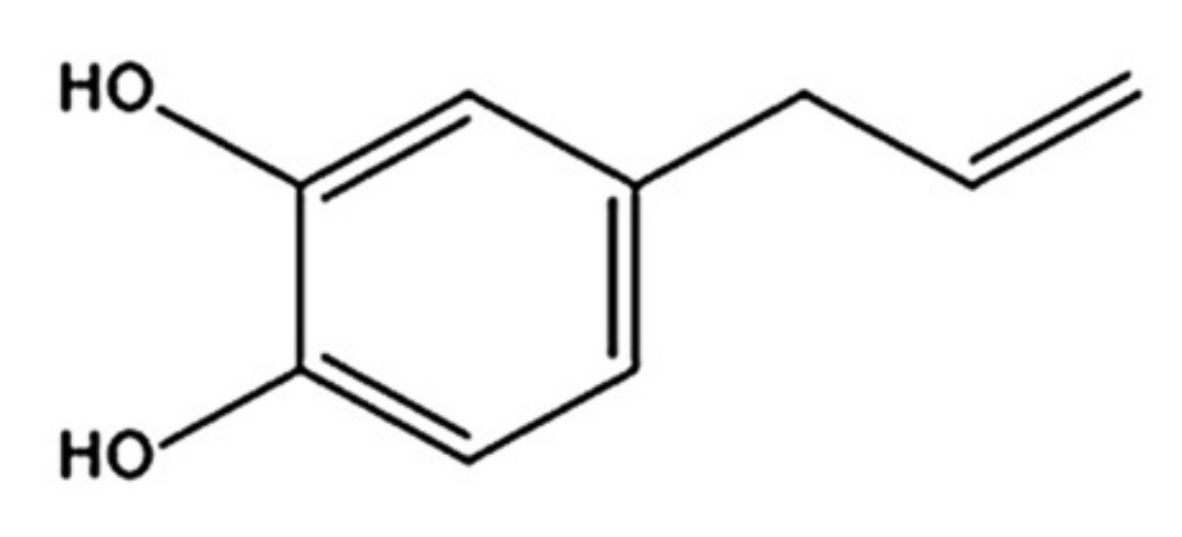
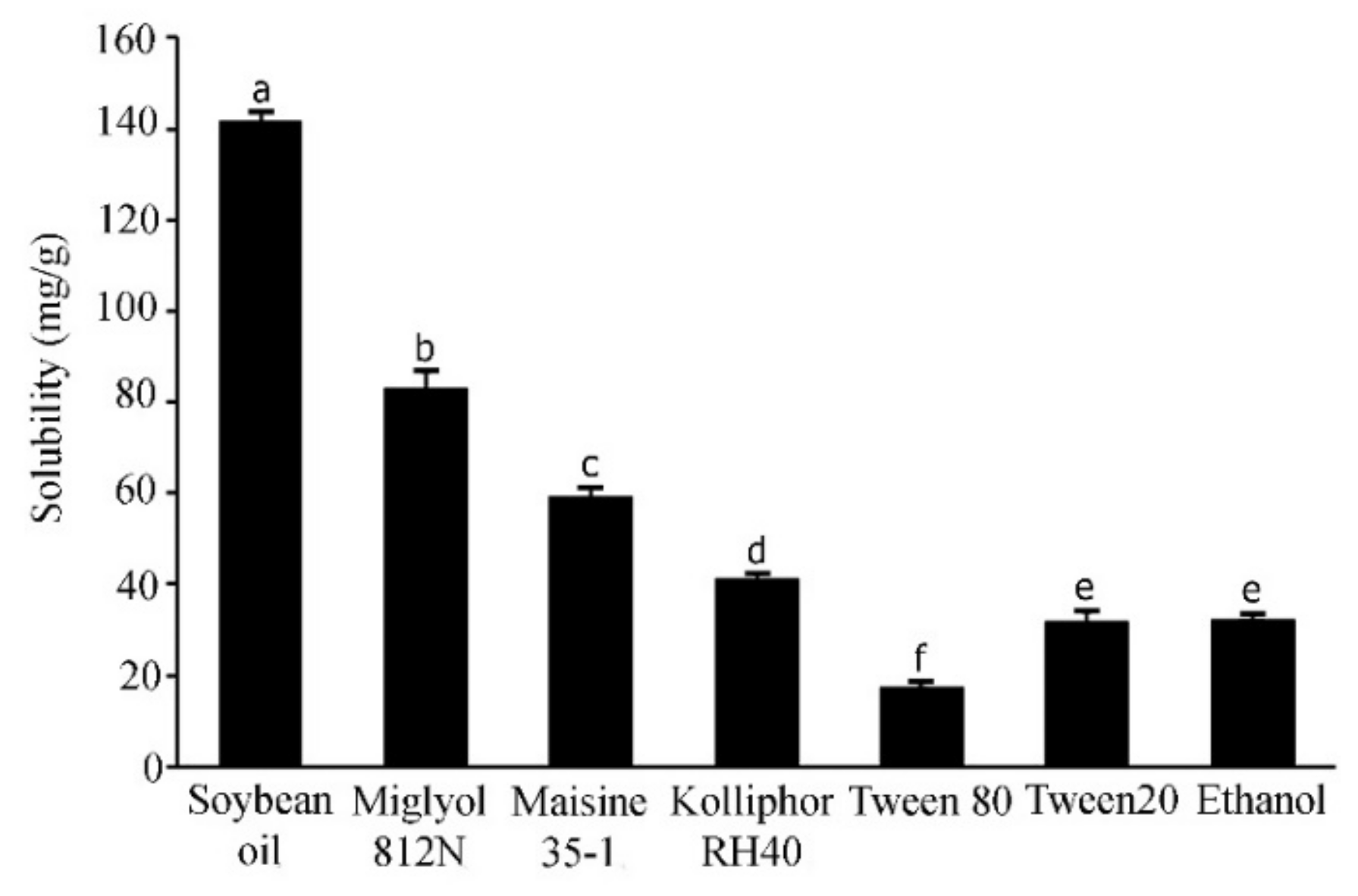
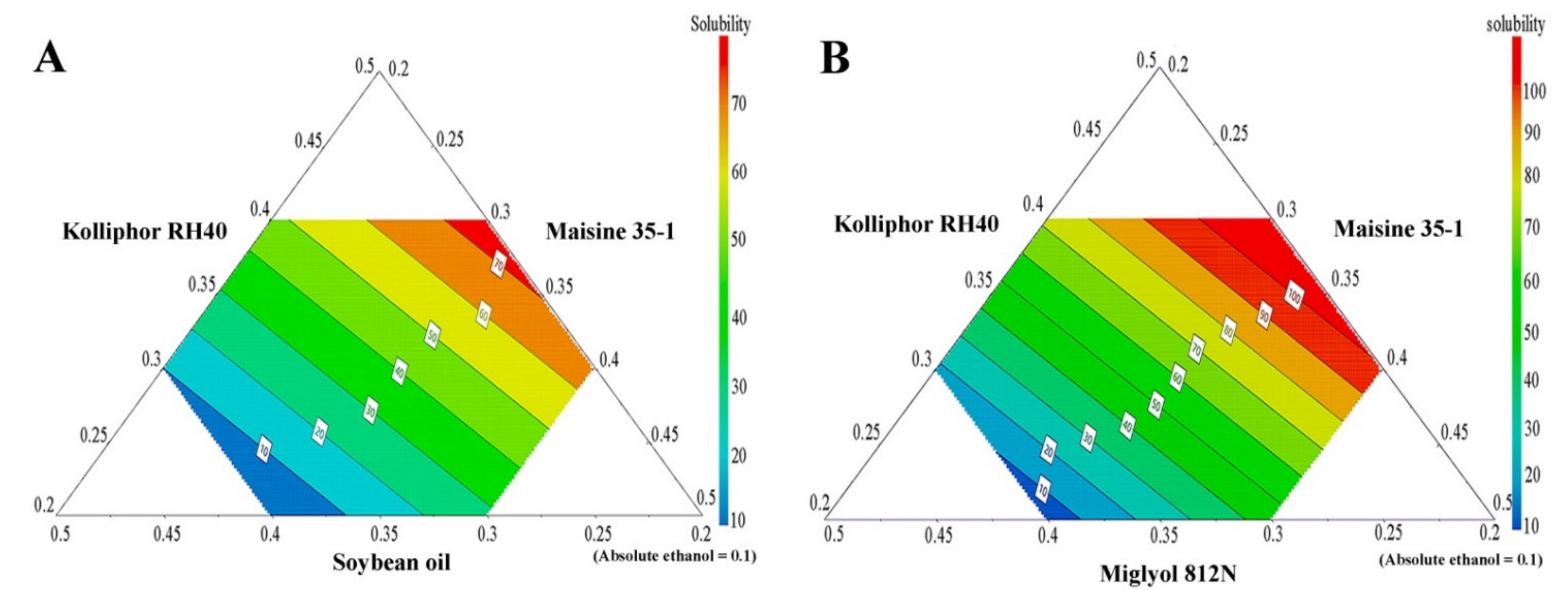
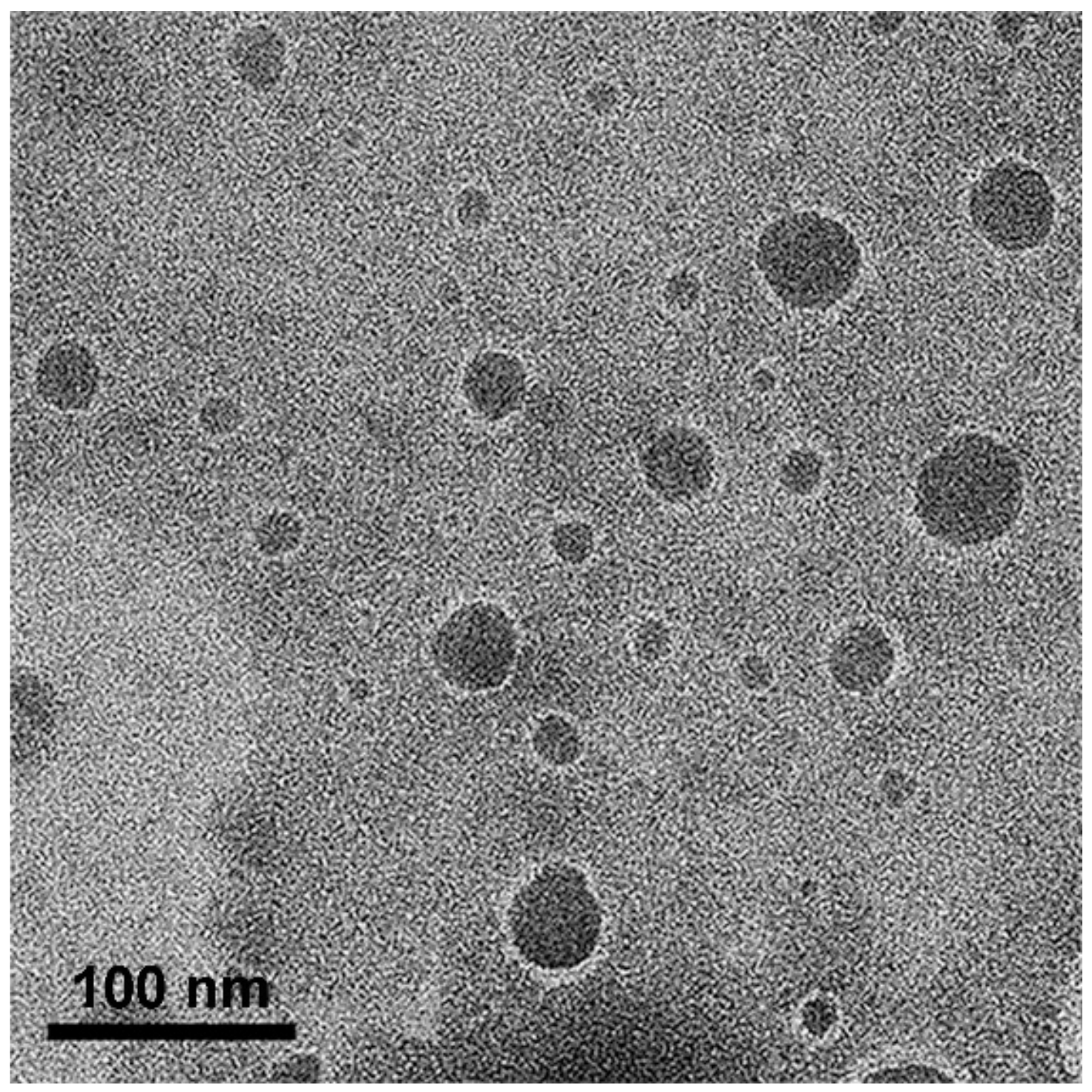
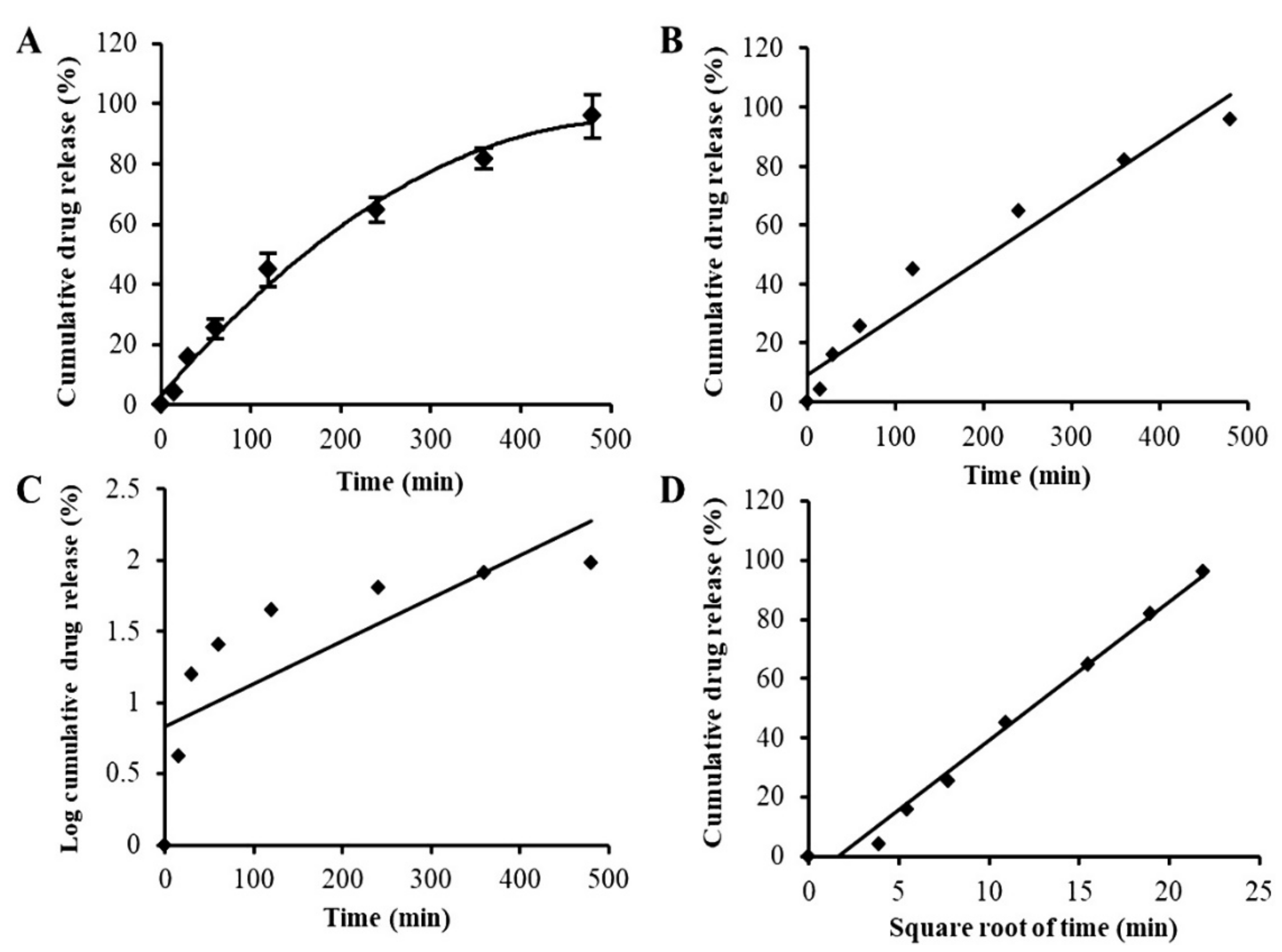
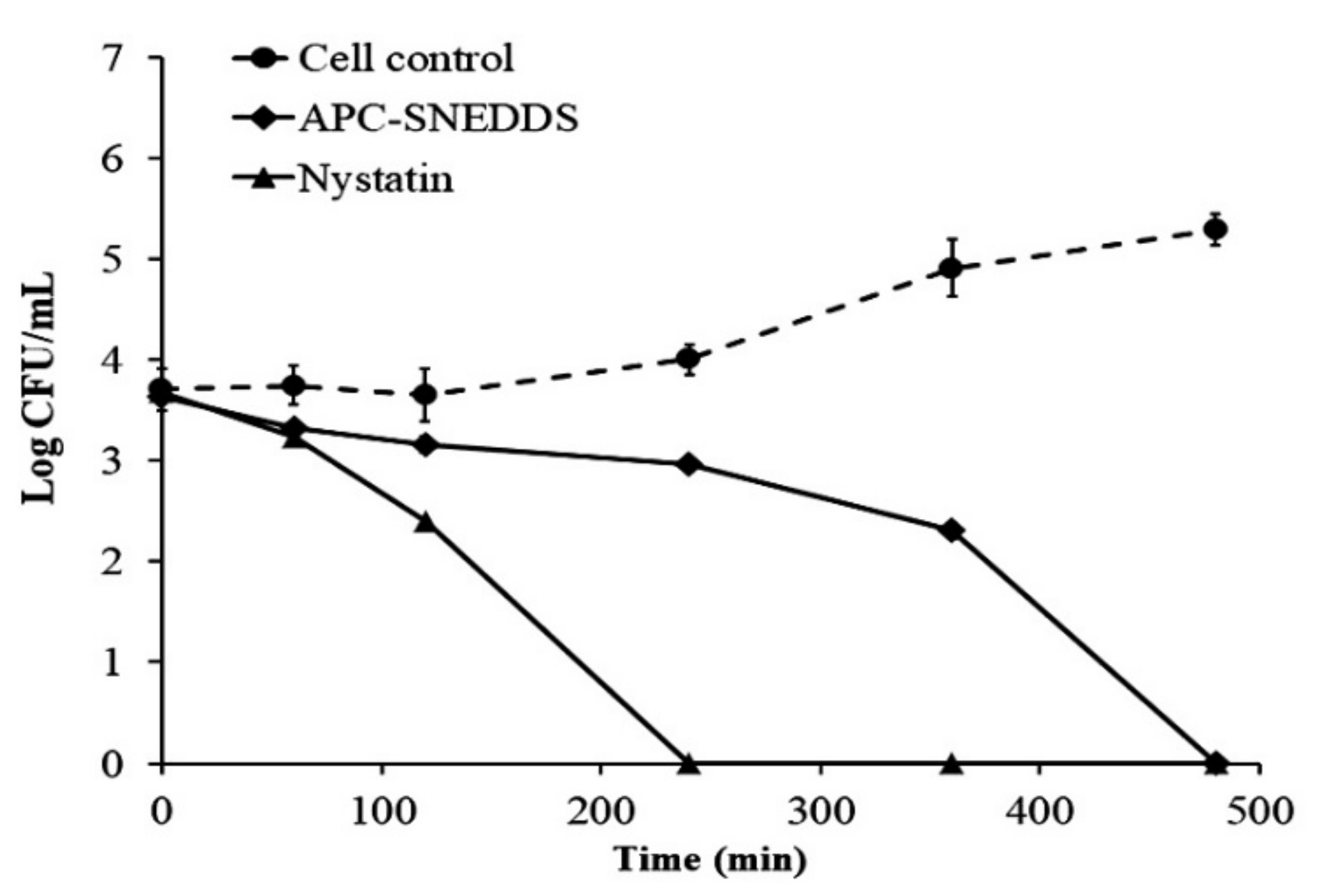

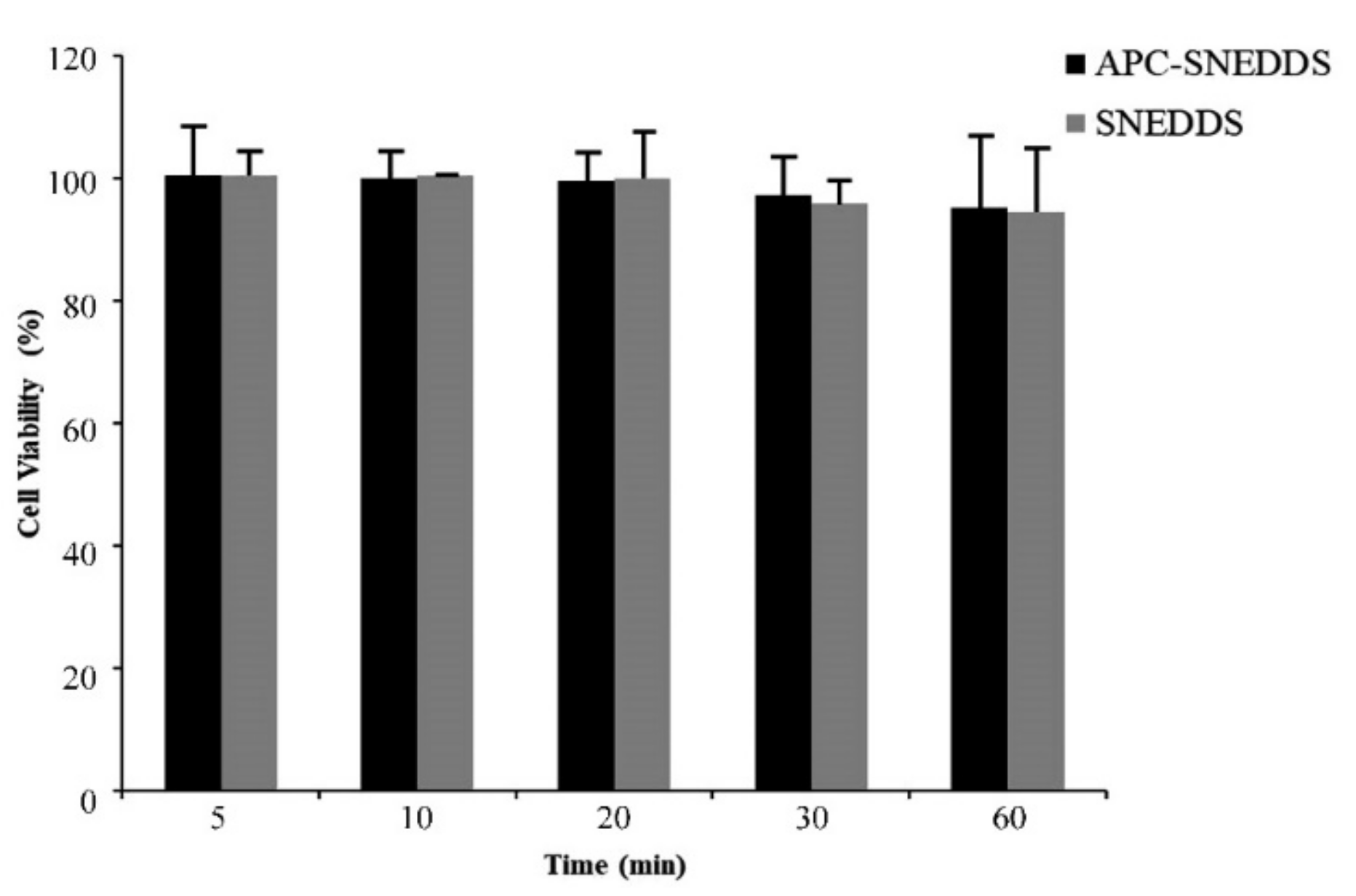
| Types | Excipients in Formulation (% w/w) | Characteristics | |||
|---|---|---|---|---|---|
| Oils: Glycerides/ Mixed Glycerides | Lipophilic Surfactants (HLB < 12) | Hydrophilic Surfactants (HLB > 12) | Co-Surfactants | ||
| I | 100 | - | - | - | Pure oils, limited or no dispersion |
| II | 40–80 | 20–60 | - | - | Moderate dispersion needed to form an emulsion |
| IIIA | 40–80 | 20–40 | - | 0–40 | Rapid dispersion to form micro- or nano-emulsion |
| IIIB | <20 | - | 20–50 | 20–50 | Rapid dispersion to form micro- or nano-emulsion |
| IV | - | 0–20 | 20–80 | 0–80 | Oil free, rapid dispersion results in micellar solution |
| Formulations | Excipients (% w/w) | ||||
|---|---|---|---|---|---|
| Soybean Oil | Miglyol 812N | Kolliphor RH40 | Maisine 35-1 | Absolute Ethanol | |
| F1 | 30 | - | 20 | 40 | 10 |
| F2 | 30 | - | 40 | 20 | 10 |
| F3 | 20 | - | 30 | 40 | 10 |
| F4 | 20 | - | 40 | 30 | 10 |
| F5 | 40 | - | 20 | 30 | 10 |
| F6 | 40 | - | 30 | 20 | 10 |
| F7 | 30 | - | 30 | 30 | 10 |
| F8 | - | 30 | 20 | 40 | 10 |
| F9 | - | 30 | 40 | 20 | 10 |
| F10 | - | 20 | 30 | 40 | 10 |
| F11 | - | 20 | 40 | 30 | 10 |
| F12 | - | 40 | 20 | 30 | 10 |
| F13 | - | 40 | 30 | 20 | 10 |
| F14 | - | 30 | 30 | 30 | 10 |
| Formulations * | Self-Emulsification Efficiency | Particle Size ** (nm) | PdI ** |
|---|---|---|---|
| F1 | C | 317.24 ± 1.34 g,h | 0.27 ± 0.08 d,e |
| F2 | D | 178.40 ± 0.42 f | 0.20 ± 0.03 c,d |
| F3 | B | 158.50 ± 1.57 e,f | 0.24 ± 0.13 c,d |
| F4 | A | 40.42 ± 0.76 a | 0.12 ± 0.02 a,b |
| F5 | D | 255.00 ± 0.99 g | 0.59 ± 0.00 f |
| F6 | C | 347.40 ± 4.34 h | 0.18 ± 0.09 a,b,c,d |
| F7 | A | 65.82 ± 0.22 a,b | 0.22 ± 0.01 b |
| F8 | B | 490.80 ± 21.43 i | 0.09 ± 0.05 a |
| F9 | A | 52.57 ± 1.35 a | 0.14 ± 0.01 a,b |
| F10 | B | 136.07 ± 7.84 e | 0.38 ± 0.06 f |
| F11 | A | 28.28 ± 0.36 a | 0.11 ± 0.02 a |
| F12 | C | 329.90 ± 9.28 h | 0.14 ± 0.03 a,b,c |
| F13 | B | 115.53 ± 1.62 c | 0.37 ± 0.01 e,f |
| F14 | A | 98.98 ± 1.62 c | 0.15 ± 0.00 a,b,c |
| Formulations | Solubility of APC in SNEDDS (mg/g) * |
|---|---|
| F1 | 38.73 ± 2.79 f |
| F2 | 65.45 ± 1.57 d |
| F3 | 91.82 ± 2.06 b |
| F4 | 77.97 ± 7.01 b,c |
| F5 | 8.75 ± 1.34 g |
| F6 | 10.45 ± 0.95 g |
| F7 | 12.36 ± 1.61 g |
| F8 | 48.01 ± 8.78 e |
| F9 | 72.55 ± 0.10 c,d |
| F10 | 91.10 ± 9.01 b |
| F11 | 141.48 ± 15.64 a |
| F12 | 45.87 ± 6.31 e,f |
| F13 | 19.77 ± 1.13 g |
| F14 | 18.19 ± 2.39 g |
| APC Concentration (mg) | Particle Size * (nm) | PdI * | Zeta Potential * (mV) |
|---|---|---|---|
| 0.4 | 35.22 ± 0.43 a | 0.15 ± 0.04 a | –17.13 ± 1.80 b |
| 0.8 | 34.59 ± 0.30 a | 0.21 ± 0.01 b | –16.20 ± 1.31 b |
| 1.6 | 33.00 ± 0.30 a | 0.14 ± 0.01 a | –20.37 ± 2.17 a |
Publisher’s Note: MDPI stays neutral with regard to jurisdictional claims in published maps and institutional affiliations. |
© 2021 by the authors. Licensee MDPI, Basel, Switzerland. This article is an open access article distributed under the terms and conditions of the Creative Commons Attribution (CC BY) license (http://creativecommons.org/licenses/by/4.0/).
Share and Cite
Okonogi, S.; Phumat, P.; Khongkhunthian, S.; Chaijareenont, P.; Rades, T.; Müllertz, A. Development of Self-Nanoemulsifying Drug Delivery Systems Containing 4-Allylpyrocatechol for Treatment of Oral Infections Caused by Candida albicans. Pharmaceutics 2021, 13, 167. https://doi.org/10.3390/pharmaceutics13020167
Okonogi S, Phumat P, Khongkhunthian S, Chaijareenont P, Rades T, Müllertz A. Development of Self-Nanoemulsifying Drug Delivery Systems Containing 4-Allylpyrocatechol for Treatment of Oral Infections Caused by Candida albicans. Pharmaceutics. 2021; 13(2):167. https://doi.org/10.3390/pharmaceutics13020167
Chicago/Turabian StyleOkonogi, Siriporn, Pimpak Phumat, Sakornrat Khongkhunthian, Pisaisit Chaijareenont, Thomas Rades, and Anette Müllertz. 2021. "Development of Self-Nanoemulsifying Drug Delivery Systems Containing 4-Allylpyrocatechol for Treatment of Oral Infections Caused by Candida albicans" Pharmaceutics 13, no. 2: 167. https://doi.org/10.3390/pharmaceutics13020167
APA StyleOkonogi, S., Phumat, P., Khongkhunthian, S., Chaijareenont, P., Rades, T., & Müllertz, A. (2021). Development of Self-Nanoemulsifying Drug Delivery Systems Containing 4-Allylpyrocatechol for Treatment of Oral Infections Caused by Candida albicans. Pharmaceutics, 13(2), 167. https://doi.org/10.3390/pharmaceutics13020167







